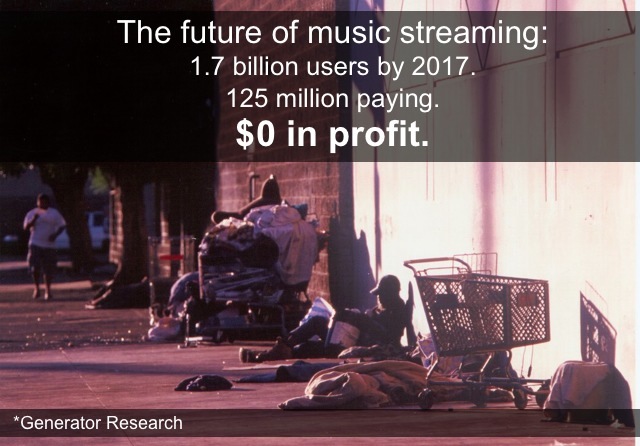In an increasingly
digital world it is no surprise that the music industry has changed drastically
in terms of the way people are listening. There is no doubt that in order to
keep up, the industry was forced to adapt to a society that has become
accustomed to instant gratification. As a result, music apps were created and
made available to the masses. Among the most popular of these apps are Spotify
and Pandora. These allow music fans to listen to countless songs and artists
either for free or with a monthly subscription. Although there is no question
whether these music apps are able to gain revenue, whether or not they will
ever make a real profit is the central issue.
According to a
report from The Recording Industry Association of America, digital sales from
music services such as Spotify, Pandora, and Rhapsody were up 39 percent from
2012 in 2013, (Friedlander). Meanwhile, “Permanent digital downloads
(including albums, single tracks, videos, and kiosk sales) declined 1.0%,” (Friedlander).
Physical shipments also declined as well, dropping 12 percent from 2012.
Obviously, it is clear that digital music services are rapidly rising in
popularity and usage. With more and more subscribers each month, these services
are beginning to overshadow permanent downloads from industry giants like iTunes.
In fact, these trends are so threatening to iTunes’ services that they have
recently released their own version of a digital streaming service in the form
of iTunes Radio. However, it has not been able to compete with Spotify or
Pandora. They are currently rumors that Apple is formulating another plan in
their fight to stay on top of the music industry.
In
a recent article from Digital Music News,
writer Paul Resnikoff
states, “
If the future of music is streaming,
then it’s a disastrously
unprofitable one.
Generator projects massive increases in
streaming usage and paid subscription, but no recognizable way to profit from
it,” (Resnikoff). No matter how popular digital streaming becomes, if the
companies involved never make a profit and shareholders are forced to take
these financial blows, the future of these seemingly successful companies
remains uncertain.

(Photo from Digital Music News)
The
reason for the lack of profit is made clear in an article written by Ben Sisario for The New York Times blog. In this
article, Sisario discusses the current financial situation for Pandora and
Spotify. He states, “Both are losing money, and for largely the same reason:
the cost of music royalties,” (Sisario). What is interesting about this is that
Pandora and Spotify go about paying royalties in different ways. Pandora pays
their fees through federally regulated channels. On the other hand, Spotify
negotiates with record companies directly. However, neither method seems to be
better than the other as both companies continuously fail to make a profit.
Although
some of Pandora’s revenue does come from paid subscribers, they rely mostly on
advertising. Yet, they cannot successfully make enough from these
advertisements to cover the steep cost of royalties. In recent years, Pandora
has been fighting to lower the cost of music royalties. Although there was a
bill created, they were not able to make it pass and therefore Pandora finds
themselves again without a solution.
In
the case of Spotify, there does seem to be some hope for profits in the
future. As Sisario points out in his article, “It’s possible that Spotify’s licensing costs could go down in
the future, as record labels monitor its progress; they could decide to make
changes to ensure that Spotify thrives and can keep sending over its royalty
checks,” (Sisario). It appears that their method of dealing directly with
record companies and music distributors could potentially pay out in the long
run. Of course, that is not currently the case.
In
the video below, the CEO of Pandora discusses the aspect of profitability for
the company. It is evident that the cost of royalties is among major concerns
for this digital streaming service.
As
the majority of people today use digital streaming to access and listen to
music, it is easy to see the success of services such as Pandora and Spotify.
Of course, it becomes questionable how long a company can stay in business if
they continue to fail to make a profit. Do you think that Pandora and Spotify
have a sustainable future in the music industry?
Kelsey Scriven
Kelsey Scriven
Sources
Works Cited
Friedlander, Joshua P. News and Notes on 2013 RIAA Music Industry
Shipment and
Revenue
Statistics. Publication. N.p.: RIAA, 2014. Print.
"Pandora Prepares for Q1 Earnings:
Video." Bloomberg.com. Bloomberg, 23 May
2013.
Web. 29 Mar. 2014.
Resnikoff, Paul. "Streaming Services
Will Never Become Profitable, Study
Finds…."Digital Music News Streaming Services Will
Never Become Profitable Study Finds Comments. N.p., 18 Feb. 2014. Web. 29
Mar. 2014.
Sisario, Ben. "Pandora and Spotify
Rake In the Money and Then Send It Off in
Royalties." Media Decoder Pandora and Spotify Rake In the
Money and Then Send It Off in Royalties Comments. The New York
Times, 24 Aug. 2012. Web. 29 Mar. 2014.